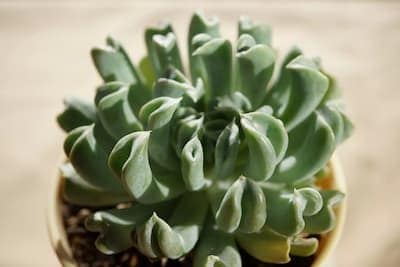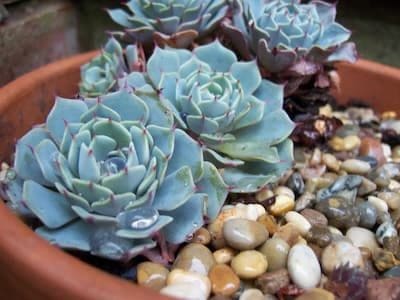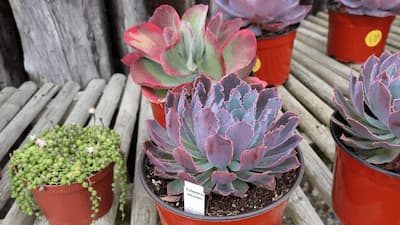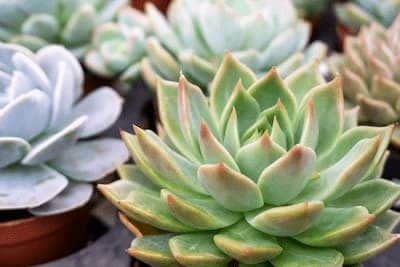Echeveria in your home
Echeveria is one of my favourite succulents. Its leaves form a beautiful rosette that reminds me of a rose flower. It’s like having a beautiful flower made of leaves. The symmetry of this succulent is amazing.
The leaves that are closer to the centre are smaller and grow at a different angle than the leaves that are on the outside of the rosette. The plant grows “from the inside” maintaining a perfect harmony of shape and size.
Echeveria can be found more and more often in the homes of Poles. It is successfully grown on the windowsill of many apartments. In this way, it decorates the interior, without requiring any special care treatments.
Let me give you a little more information about this wonderful plant.
Where does this succulent come from?
Some sources say it comes from Mexico. According to the Brittanica encyclopedia, Echeveria (Echeveria) comes from regions from Texas to Argentina. This group of plants includes over 150 varieties. Echeverias come from the stonecrop (Crassulaceae) family and are successfully cultivated practically all over the world.
Collectors who grow these succulents appreciate the compact rosette that forms a distinctive flower. The individual leaves are very fleshy, most often in a shade of green. Sometimes there is a red border on the leaves, which can be seen in the intense sun.
Echeveria – varieties and types that are most often cultivated
As I mentioned earlier, Echeveria has over 150 different varieties and it is practically impossible to describe them all. However, I decided to show you a few of them. I chose the varieties that are most common and the ones that I like the most.
After all, I’m a succulent freak so I had to take a closer look at them ?
Perle von Nurnberg (Echeveria “Perle von Nurnberg”)

Photo: Arkela / Getty Images
This is perhaps the most famous form of Echeveria. She can often be found in flower shops and conservatories. It is distinguished by a highly developed rosette with significantly larger leaves. Its leaves are rounded, but the central part of the leaf forms a characteristic spike. Young leaves sprout from the central part, developing like a rosebud.
The colours of this variety of Echeveria are also very interesting. In the evening, with a small amount of light, its leaves turn grey. In turn, in the intense light of the day, they turn deep purple and pink. When it comes to growing it, like most succulents, it likes well-drained soil, infrequent watering and bright rooms.
- Origin: Central America
- Height: approx. 12.5 cm
- Sun exposure: full, partial
Painted Echeveria (Echeveria nodulosa)

Photo Getty Images
Echeveria noudulosa, popularly known as Painted Echeveria, is a truly unique succulent. Its leaves have a completely different shape than the others. Of course, they all form a characteristic rosette, but what can surprise you are the leaves. Their colour is dark green with intense red stripes.
The red colour turns purple in places, especially in young leaves. Speaking of leaves, it is worth mentioning that they resemble small boats ?
I like this variety very much because of the colour and shape of the leaves. This variety of Echeveria has strong, fleshy leaves. There is one more thing that distinguishes this variety from the others.
It’s size!
This variety can grow to a height of 60 cm and a rosette span of about 25 cm. So it’s worth taking this into account if you are interested in breeding this variety at home. It will need a lot of space, but it will certainly reward her with an amazing appearance.
- Origin: Central America
- Height: up to 60 cm
- Sun exposure: full, partial
Black hens and chicks (‘Black Prince’)

Photo: Satakorn / Getty Images
This variety of Echeveria is characterized by dark purple, triangular leaves. It is often called “chickens and chicks” due to the compact design of the rosette. This echeveria readily produces new rosette leaves (chicks) that are light green at first and darken as the plant grows.
To maintain the right colour, this variety requires regular sun exposure. It should be in direct sunlight for several hours a day, so consider your home location carefully if you want to have it at home. It is also worth mentioning that “The Black Prince” can bloom. In autumn and winter, stems with dark red flowers bloom from this variety. Great view at the end of summer.
- Origin: Central America
- Height: up to 15 cm
- Sun exposure: full, partial
Topsy Turvy (Echeveria runyonii “Topsy Turvy”)

Photo: TokioMarineLife / Getty Images
Topsy Turvy is another succulent plant that has a very unusual appearance. Its green-blue leaves have curved tips, the shape of which makes the plant close in a moment. This variety of fast-growing Echeveria requires well-drained soil and little watering. In addition, it is good to grow it in dry, well-ventilated rooms. Room airing is usually good for plants, but this species requires a little more.
In warm countries, it can grow both indoors and outdoors. unfortunately, in the Polish climate zone, we can only grow this variety at home. As a curiosity, I would like to add that this variety won the prestigious Horticulture Award from the Royal Horticulture Society in Great Britain. All in all, quite deservedly because the appearance of this succulent is truly unique.
- Origin: Central America
- Height: up to 15cm
- Sun exposure: full, partial
“Dusty Rose”

“Dusty Rose” is a very popular variety of Echeveria. It is characterized by a purple rosette and the fact that it blooms many times a year. Its flowers are bright orange and grow like other varieties on a long stem. Each rosette can grow up to 20 cm in diameter. Of course, under ideal conditions, which in Poland are difficult to achieve. This variety also requires infrequent watering, well-drained soil (preferably sandy)
- Origin: Central America
- Height: up to 15cm
- Sun exposure: full, partial
Mexican snowball (Echeveria elegans)

Photo: stephen boisvert / Flickr / CC BY 2.0
I love this strain for its playful name and beautiful spiked leaves. ‘Echeveria Elegans’ is an exceptionally popular variety also known as ‘Mexican Snowball’. This succulent has bright leaves of distinctive green-blue colour. When I look at it, I also use a shade of grey and it’s really hard for me to name this colour. Undoubtedly, it is the beautiful colours and the shape of the rosette that deserve attention. It reproduces by cut off leaves that can be rooted or by suckling (similar to aloe vera).
- Origin: Central America
- Height: up to 20 cm
- Sun exposure: full, partial
Woolly rose (‘Doris Taylor’)

Photo: Quinn Dombrowski / Flickr / CC BY-SA 2.0
This variety of Echeveria owes this name to its fluffy leaves. Contrary to other varieties, this écheveria does not like too long sun exposure. Such varieties of succulents grow very often around boulders and stones, which over time cast a shadow for the plant. When it comes to breeding, it may take longer than with the rest of the varieties, but be patient.
- Origin: Central America
- Height: up to 7.5 – 12.5 cm
- Sun exposure: filtered, partial
“Neon Breakers”

Photo: cultivar413 / Flickr / CC BY 2.0
In direct sunlight, the purple leaves with jagged edges turn lighter. It was this effect that made them receive such a unique name. This echeveria grows perfectly in homes, where it reaches a rosette size of up to 7.5 cm. When breeding at home, Jadnak should remember to provide it with the right amount of light.
Insolation is very important when growing succulents, and this variety is quite sensitive to it. Without the right amount of light, the Neon Breakers will not “shine”. As for the rest of the conditions, this variety also likes well-drained soil. It does not have to be sandy, but the water should flow freely through it.
- This variety does not tolerate frosts, so in no way can it be grown in Poland, outside. However, it can be exposed to the sun in the summer. Then it will look beautiful in the rays of the sun.
- Origin: Central America
- Height: up to 7.5 cm
- Sun exposure: full, partial
“Tippy”

Photo: Nora Carol Photography / Getty Images
This variety of Echeveria is characterized by green and blue leaves that form a distinctive rosette. The rosette can reach a size of up to 15 cm in diameter. This is quite a lot for Echever, so remember to have adequate space for it. This variety has characteristic pointed leaves. The tips of the leaves are reddish. This variety can be easily planted with leaves and suckers. When it comes to the soil for this variety, a sandy substrate is best. It must be well-drained.
- Origin: Central America
- Height: up to 15 cm
- Sun exposure: full, partial
Ghost (Echeveria lilacina)

Photo: Jean-Michel Moulle / Flickr / CC BY 2.0
Echeveria “Ghost” also known as “Echeveria lilacina” is a very elegant variety of these wonderful succulents. It has a very distinctive appearance. The compact rosette and the leaves growing nearby make it look like a rose flower. The colour also adds elegance to it.
A light grey succulent with blue spots in places is a great choice for a modern home window sill. Unlike other varieties, this écheveria does not like direct sunlight. In direct sunlight, its leaves can get burned
- Origin: Central America
- Height: up to 15-30cm
- Sun exposure: partial, tolerates the sun, but too long exposure can burn leaves
Echeveria – a flower in the window
Echeveria is a very graceful species of succulents. If you take care of her basic needs and create the right conditions for her, she can repay her with beautiful flowers. Most varieties of Echeveria bloom at least once a year.
At first, in the rosette, you can see the stalk expressing. I remember the first time one of my echeverias bloomed. I honestly admit that I thought the succulent had gone wild for me. I look in the morning, and here a stalk grows out of the centre of the rosette.
First, I just wanted to cut it off, but luckily I started browsing the internet looking for some explanation ?
I am writing this so that you, dear reader, would not approach it the way I did. After a few days, when the stem is the right length, a small bud will start to appear at the end of the stem.
This will be the beginning of a beautiful flower to grow out of your Echeveria.
Surely you are now wondering how to increase your chances of getting an Echeveria flower? I follow a few simple tips:
- Use well-drained soil. If you do not know what soil to use, I encourage you to read my guide titled ” Aloe – what soil is the best?” “. In it, I describe the preparation of soil for succulents step by step. You can use this article to prepare the ground for the Echeveria yourself.
- Take care of proper watering. In this case, I also refer you to my previous article, in which I write how to water succulents . If you don’t have time to read the entire article, my suggestion is that you should water a lot, but rarely. Watering is just one part of growing succulents. If you have an unsuitable pot, you will surely overflow the Echeveria and start to turn brown or lose leaves. You need to ensure that the pot has adequate drainage, i.e. holes at the bottom. The combination of a suitable pot with well-drained soil will allow you to water well Echeveria and any other succulent.
- Take care of adequate sun exposure. As you can see different types of esheveria, they like different amounts of sunlight. Most varieties like direct sunlight, but not all of them, so you need to adapt to the variety you have. Too much sun can burn the leaves of the Echeveria, and the plant will spend a lot of energy to regenerate itself. In such a situation, it will definitely not bloom.
- Air humidity is equally important. Succulents come from places where water is hard to come by. If your house or apartment is too humid, the succulent may not bloom either.
- Take care of proper fertilization. The rule here is a small amount of fertilizer, although sometimes I make exceptions. The problem with succulents in Poland is that they come from greenhouse crops, producers want the plant to grow as soon as possible in order to be able to sell it. So they use various types of specifics and chemicals that accelerate growth, but unfortunately make the plant dependent on fertilizer. In my experience, a little cactus fertilizer that you can buy from a garden store or Castorama won’t hurt. You can apply such a fertilizer as soon as the plant wakes up after a winter sleep. As a rule, we only fertilize plants when they are growing intensively. It is most common in early spring and summer. Later we stop fertilizing because the plants are used to overwintering.

